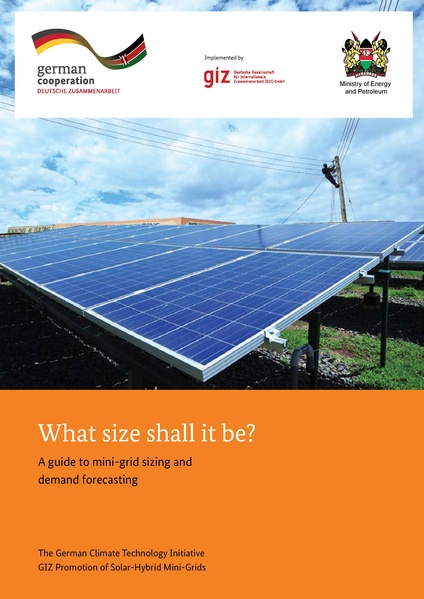File:Mini-Grid Sizing Guidebook.pdf
 Size of this JPG preview of this PDF file: 424 × 599 pixels. Other resolution: 170 × 240 pixels. |
Original file (2,007 × 2,834 pixels, file size: 0 bytes, MIME type: application/pdf, 68 pages)
Summary
The 'Mini-grid sizing guidebook’ aims at providing a quick understanding of the ruling principles of electricity demand assessment and mini-grid system sizing. For the successful implementation of mini-grids in rural areas, adequate load assessment and demand forecast, as well as subsequent system sizing, are essential. The economic viability of mini-grid projects depends on the size of the installed assets - and thus the investments - which need to be backed by a payable demand in the years after commissioning. A wrongly configured system (e.g. too small or too large) will either not serve its purpose or not recover the cost required to set it up.
A mini-grid is a set of small-scale electricity generators and possibly energy storage systems interconnected to a distribution network that supplies electricity to a limited number of customers. The combination of photovoltaic(PV) systems with a diesel genset and/or storage system is a flexible and usually least-cost solution for the electrification of rural communities. Thus, this technology is able to tap the solar energy potential, to provide rapid, cost-effective and high quality electrification, and to allow a profit investment on renewable energy sources.
For providing off-grid areas, especially remote regions, with electricity access, mini-grids will play a significant role. Thereby, while fostering an effective implementation of PV-diesel-battery-hybrid mini-gridpower plants, this guidebook will also contribute to the ultimate goal of sustainably enhancing rural electrification in sub-Saharan Africa.
This guidebook is divided into four chapters. Chapter 1 gives a basic introduction and overview about sizing mini-grids. Chapter 2 describes the sizing procedure for mini-grids, including a description of required data and information. The methods for the assessment of energy demand are explained in detail, and the correction of the assessed demand to the effective demand is discussed. Furthermore, forecasting energy demand and recommendations on system sizing are addressed. Chapter 3 gives an overview of existing system sizing tools, focusing on the mini-grid builder and HOMER (Hybrid optimization of multiple energy resources). Chapter 4 entails a conclusion and some final recommendations to users of the tools and handbook.
Bibliography
Fricke, D. (2015): “Qinous Energy Solutions: PV Hybrid in Off-Grid and Mini-Grid
solutions”. Presentation given in Manila, October 2015.
GIZ (2015): Mini-grid builder: Web-Based Mini-Grid Tool. Available from
http://www.minigridbuilder.com/ [accessed 21 June 2016]
HOMER (2016): Homer Energy Support Knowledgebase.
http://support.homerenergy.com/index.php?/Knowledgebase/Article/View/272/90/10070---dispatch-strategy [Accessed: 17th June 2016]
IEA (2015): World Energy Outlook 2015. International Energy Agency, Paris, France.
Available from http://www.worldenergyoutlook.org/weo2015// [accessed: 17
December 2015]
IEA (2014): Africa Energy Outlook 2014. International Energy Agency, Paris, France.
Available from http://www.worldenergyoutlook.org/africa/ [accessed 15 June
2016]
IEA (2013): Rural Electrification with PV Hybrid Systems. International Energy
Agency, Paris, France. ISBN: 978-3-906042-11-4
IEA and World Bank (2015): Sustainable Energy for All 2015—Progress Toward
Sustainable Energy 2015. World Bank, Washington, DC. Available from
http://www.se4all.org/sites/default/files/l/2013/09/GTF-2105-Full-Report.pdf
[accessed 15 June 2016]
IRENA (2015): IRENA Off-grid Renewable Energy Systems: Status and methodological
issues. International Renewable Energy Agency (IRENA) Innovation and
Technology Centre, Bonn, Germany
NRECA (2011): Guides for Electric Cooperative Development and Rural Electrification,
NRECA International, http://www.nreca.coop/what-we-do/internationalprograms/
RECP (2014): Mini grid policy toolkit. European Union Energy Initiative Partnership
Dialogue Facility (EUEI PDF), Eschborn, Germany
SDGH (2014): Solar/Diesel Mini-Grid Handbook. Power and Water Corporation
(PWC), Darwin, Australia
World Bank (2016): Current Activities and Challenges to Scaling up Mini-Grids in
Kenya. Energy Sector Management Assistance Program (ESMAP). World Bank,
Washington, DC.
Licensing
|
File history
Click on a date/time to view the file as it appeared at that time.
| Date/Time | Thumbnail | Dimensions | User | Comment | |
|---|---|---|---|---|---|
| current | 11:37, 6 September 2016 |  | 2,007 × 2,834, 68 pages (0 bytes) | ***** (***** | *****) | User created page with UploadWizard |
You cannot overwrite this file.
File usage
The following 2 pages use this file:





















